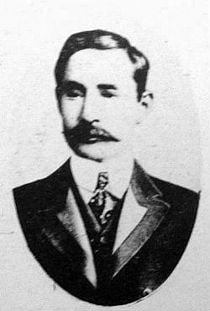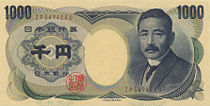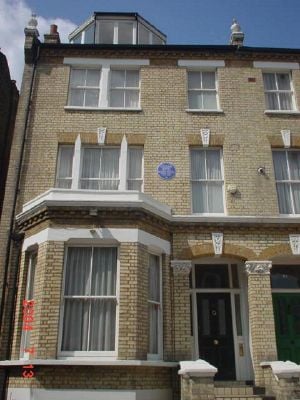Natsume Soseki
 From Nwe
From Nwe 
Natsume Soseki (夏目 漱石 in Japanese; February 9, 1867 - December 9, 1916) was the pen name of Natsume Kinnosuke (夏目金之助), one of the foremost Japanese novelists of the Meiji Era. Soseki, along with Mori Ogai, is considered one of the two greatest early modern Japanese writers. After studying in England on a government scholarship, Soseki began a career at Tokyo University as a scholar of English literature, but later resigned to devote himself to writing. His first book, Wagahai wa neko de aru (I Am a Cat), a satire on human vanity, was followed by increasingly pessimistic novels such as Kokoro (Heart) and his unfinished masterpiece, Meian (Light and Darkness). He was also a scholar of British literature and a composer of haiku, Chinese-style poetry, and fairy tales. The alienation of modern humanity, the search for morality and the difficulty of communication were common themes throughout Soseki’s works. From 1984 until 2004, his portrait appeared on the front of the Japanese 1,000-yen note.

Early years
Natsume Kinnosuke was born on February 9, 1867, just one year and a half before the start of the Meiji Reformation, in Edo (modern-day Tokyo). His father, Naokatsu, was the hereditary chief of a small town in Edo. When Natsume was born, Naokatsu was fifty years old, his wife Chie was forty-one, and they had five sons and three daughters. Bearing a child late in life, in those days, was regarded as “the shame of woman.” Chie was ashamed to have a child at her advanced age and, as the last baby of many children, Natsume was placed in a foster home at either a second-hand store or a vegetable shop. Kinnosuke’s elder sister found that he was being kept in the shop until late at night (the shop was probably kept open until midnight), confined in a bamboo cage beside the merchandise. Unable to look on in silence any longer, she brought him home.
When Natsume Kinnosuke was one year old, his parents foisted him off again, this time on a former household servant, Shiobara Masanosuke, and his wife. Natsume began his life as an unwanted child. Although he was brought up indulgently until the age of nine, Shiobara Masanosuke and his wife eventually separated and Natsume was returned to his family home. He was welcomed by his mother, but his father regarded him as a nuisance. When he was fourteen, his mother died. The solitude and defiance that he exhibited later in life came not only from his character, but from the surroundings in which he grew up. After his return home, he was required to call his parents “grandparents.” His elder brother, who frequented geisha houses, sometimes took him along, but Natsume did not follow his example. He had many opportunities to stray into trouble, but he did not take them.
No one kept any detailed records from Natsume’s youth, because no one imagined that he would amount to anything. In middle school, Natsume became enamored with Chinese literature, and fancied that he might someday become a writer. However, his family disapproved strongly of this course of action, and when Natsume entered Tokyo Imperial University (now the University of Tokyo) in September of 1884, it was with the intention of becoming an architect. He began studying English, feeling that it might prove useful to him in his future career. He wrote papers on Walter "Walt" Whitman and the English poets.
In 1887, Natsume became friends with Masaoka Shiki, who gave him encouragement on the path to his future career as a writer. Shiki tutored him in the art of composing haiku. From this point on, Natsume began signing his poems with the name Soseki, which is a Chinese idiom meaning "stubborn." In 1890, Soseki entered the English literature department, and quickly became a master of the English language. Soseki graduated in 1893, and enrolled for some time as a graduate student and part-time teacher at the Tokyo Normal School.
In 1895, Soseki began teaching at Ehime Prefecture Middle School in Shikoku, the setting for his novel Botchan. Along with fulfilling his teaching duties, Soseki published haiku and Chinese poetry in a number of newspapers and periodicals. He resigned this post in 1896 and began teaching at the Fifth High School in Kumamoto. On June 10, 1896, he married Nakane Kyoko, whose father was a chief secretary of the House of Peers.

Soseki in the United Kingdom, 1901-1902
In 1900, Soseki was sent by the Japanese government to study in Britain. He visited Cambridge and stayed a night there, but gave up the idea of studying at the university because he could not afford it on his government scholarship. He had a difficult life in London, living in four different lodgings and spending most of his days indoors buried in books; his friends feared that he might be losing his mind. He also visited Pitlochry in Scotland. He broadened his knowledge of English literature and returned to Japan at the end of 1902. Soseki became a professor of English literature at Tokyo Imperial University. Five years later, in his preface to Bungakuron (The Literary Criticism), he wrote about his time in London: "The two years I spent in London were the most unpleasant years in my life. Among English gentlemen I lived in misery, like a poor dog that had strayed among a pack of wolves." In 1984, the Soseki Museum in London was opened by Sammy I. Tsunematsu.
Literary career
Soseki's literary career began in 1905, when he wrote a short story entitled I Am a Cat, which was such a public success that he began serializing it in Hototogisu (A Little Cuckoo), a prominent literary journal of the time, founded by his friend Masaoka Shiki. A short time later he published Botchan, another work which won him admiration from the public as well as critical acclaim. He began writing full time in 1907, when he left his post at the university for a position with Asahi Shimbun (one of the largest newspapers in Japan). He began writing one novel a year until his death from a stomach ulcer in 1916.
Role of the protagonist in Soseki’s works
Sokeki started to write I Am a Cat as a literary sketch. Although the literary sketch appeared to be a novel, it went against the style of literature in vogue at that time. Soseki’s purpose in writing differed from that of his contemporaries. Soseki explained that one of the special features of the literary sketch was that it had no story lines. I Am a Cat was written with no clear story lines. The direction of the story gradually deviates from its course and the content becomes darker and deeper; the story lines are tied together only by the Cat, which is wandering about.
To the Spring Equinox and Beyond was written in a style similar to I Am a Cat using Keitaro, the protagonist, in the same manner as the Cat. Keitaro never enters the world of Sunaga and Chiyoko, but wanders around the areas surrounding them. By making Keitaro the protagonist, Soseki portrays their serious situation as literary scenery. Keitaro wants to become a detective. However, both he and the Cat are not real detectives, out to catch criminals, but observers trying to piece together other people's lives. Soseki portrayed many such "educated idlers" in his works.
When Soseki wrote I Am a Cat in 1905, the mainstream Japanese literary world was under the influence of French naturalism. Soseki plunged into this literary world as an outsider. Most writers did not regard his works as literature. Soseki despised the “modern literature” of his time because it employed an impoverished vocabulary, composing “expressions” of simple words which were meant to convey a deeper meaning. In that atmosphere, Soseki’s cultured and multi-toned sentences attracted considerable attention. Before starting a book, Soseki would read dictionaries to enrich his palette of colorful words so that he could describe sights and feelings with precise detail. His third book, Kusamakura (The Three-Cornered World), about a painter, another “educated idler,” who goes to stay in a remote village, is lyrical and poetic. Soseki himself said about Kusamakura that such a novel had never been seen before in history.
Essence of Soseki’s literature
Soseki became a popular writer with the publication of his first book, and he remains a favorite Japanese author. His books had a depth that was rooted in the cultural heritage of the past, from which most writers in his day detached themselves. Modern writers had begun to deny the black-and-white Confucian ethics and the sensuality of Edo (Tokyo), which Soseki had inherited in his nature. The essence of Soseki’s literature was a type of Edo sensibility embodied by yose, a traditional Japanese variety theater. Yose was composed of two elements: Long, enrapturing songs chanted to the accompaniment of a samisen (three-string Japanese guitar), often with drums and flutes added; and Confucian themes of right and wrong.
Although Soseki had begun his life as an unwanted child, his father, Naokatsu, was the hereditary chief of a small town in Edo. The position of chief, who had authority over the town administration and police, was in a special class which bridged the gap between the Samurai class and the tradesmen and artisans. His foster father, Shiobara Masanosuke, belonged to a high-ranking class of tradesmen and artisans. Soseki grew up exposed to the culture of both the Samurai and the tradesmen and artisans. Tsubouchi Shoyo (1859-1935), who represented modern literature of that time, wrote Shōsetsu Shinzui (The Essence of the Novel), in which he broke off his relationship with the old Edo culture, to which Soseki clung. The general public still longed for the Confucian standards of right and wrong, and they discovered them in Soseki’s works.
Another reason for Soseki’s popularity is that he could discern the dark side of modernity. He went to London in the fall of the last year of the nineteenth century, and watched as the funeral procession of Queen Victoria passed the corner of Hyde Park. His experience studying in London, when he was distracted with grief to the depth of his being, contributed to the novelty of his writing. He kept the sensibility and the ethics of the past, and at the same time tried to overcome the problems of modernity. For example, in Botchan, the hero Botchan embodies the sensibility and ethics of the past while, together with the teacher Yamaarashi, he is running full speed toward modern culture. The book, with its humorous and jocular stories, is Soseki’s curse on “modern life” or modernity.
A major theme in Soseki's works was an examination of the “egoism” concealed in modern culture. In To the Spring Equinox and Beyond, the characters’ lewd and lascivious egoism is exposed to the public. In Kojin (The Wayfarer; 1912-13) Soseki describes a professor who, hopelessly consumed with jealousy, doubts his brother and his wife and insults them without any sort of self-examination. In Kokoro (Heart; 1914) Soseki depicts a cowardly hero who betrays his friend and causes his death, then monopolizes his friend's lover. Although in the autobiographical Michikusa (Grass on the Wayside; 1915) Soseki inquires into “egoism” less closely and exhibits a warm regard toward actual life, in his last incomplete work, Meian (Light and Darkness; 1916), Soseki portrays egoists who fight tooth and nail over every little thing, give way and finally abandon their “egos.” During his last days Soseki often muttered to himself, "Sokuten-Kyoshi," which meant "Yield to heaven and nature and lay down ego."
Other major themes in Soseki's works include ordinary people fighting against economic hardship, the conflict between duty and desire, loyalty and group mentality versus freedom and individuality, personal isolation and estrangement, the rapid industrialization of Japan and its social consequences, contempt of Japan's aping of Western culture, and a pessimistic view of human nature.
Works
|
|
References
ISBN links support NWE through referral fees
- Rimer, Thomas J. and Gessel, Van C., eds. 2005. The Columbia Anthology of Modern Japanese Literature: From Restoration to Occupation, 1868-1945 (Modern Asian Literature Series). Columbia University Press.
- Soseki, Natsume and Tsunematsu, Itsuo. 2002. Spring Miscellany and London Essays. Tuttle Publishing.
- Soseki, Natsume. 1994. Zen Haiku: Poems and Letters of Natsume Soseki. Translated by Soiku Shigematsu. First edition. Weatherhill.
- Yiu, Angela P. 1998. Chaos and Order in the Works of Natsume Soseki (Study of the East Asian Institute). University of Hawaii Press.
External links
All links retrieved November 11, 2022.
- Soseki Natsume, Gutenberg project
- Sōseki page including links to the entire text of Kokoro
- Soseki Project
Credits
New World Encyclopedia writers and editors rewrote and completed the Wikipedia article in accordance with New World Encyclopedia standards. This article abides by terms of the Creative Commons CC-by-sa 3.0 License (CC-by-sa), which may be used and disseminated with proper attribution. Credit is due under the terms of this license that can reference both the New World Encyclopedia contributors and the selfless volunteer contributors of the Wikimedia Foundation. To cite this article click here for a list of acceptable citing formats.The history of earlier contributions by wikipedians is accessible to researchers here:
- Natsume Soseki history
The history of this article since it was imported to New World Encyclopedia:
- History of "Natsume Soseki"
Note: Some restrictions may apply to use of individual images which are separately licensed.
↧ Download as ZWI file | Last modified: 02/04/2023 03:53:48 | 60 views
☰ Source: https://www.newworldencyclopedia.org/entry/Natsume_Soseki | License: CC BY-SA 3.0
 ZWI signed:
ZWI signed: KSF
KSF